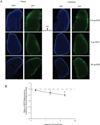In vivo visualization of olfactory pathophysiology induced by intranasal cadmium instillation in mice
- PMID: 21443902
- PMCID: PMC3951954
- DOI: 10.1016/j.neuro.2011.03.007
In vivo visualization of olfactory pathophysiology induced by intranasal cadmium instillation in mice
Abstract
Intranasal exposure to cadmium has been related to olfactory dysfunction in humans and to nasal epithelial damage and altered odorant-guided behavior in rodent models. The pathophysiology underlying these deficits has not been fully elucidated. Here we use optical imaging techniques to visualize odorant-evoked neurotransmitter release from the olfactory nerve into the brain's olfactory bulbs in vivo in mice. Intranasal cadmium chloride instillations reduced this sensory activity by up to 91% in a dose-dependent manner. In the olfactory bulbs, afferents from the olfactory epithelium could be quantified by their expression of a genetically encoded fluorescent marker for olfactory marker protein. At the highest dose tested, cadmium exposure reduced the density of these projections by 20%. In a behavioral psychophysical task, mice were trained to sample from an odor port and make a response when they detected an odorant against a background of room air. After intranasal cadmium exposure, mice were unable to detect the target odor. These experiments serve as proof of concept for a new approach to the study of the neural effects of inhaled toxicants. The use of in vivo functional imaging of the neuronal populations exposed to the toxicant permits the direct observation of primary pathophysiology. In this study optical imaging revealed significant reductions in odorant-evoked release from the olfactory nerve at a cadmium chloride dose two orders of magnitude less than that required to induce morphological changes in the nerve in the same animals, demonstrating that it is a more sensitive technique for assessing the consequences of intranasal neurotoxicant exposure. This approach is potentially useful in exploring the effects of any putative neurotoxicant that can be delivered intranasally.
Copyright © 2011. Published by Elsevier B.V.
Figures




Similar articles
-
Intranasal exposure to manganese disrupts neurotransmitter release from glutamatergic synapses in the central nervous system in vivo.Neurotoxicology. 2012 Oct;33(5):996-1004. doi: 10.1016/j.neuro.2012.04.014. Epub 2012 Apr 20. Neurotoxicology. 2012. PMID: 22542936 Free PMC article.
-
From the Cover: Cadmium Exposure Differentially Alters Odorant-Driven Behaviors and Expression of Olfactory Receptors in Juvenile Coho Salmon (Oncorhynchus kisutch).Toxicol Sci. 2016 Dec;154(2):267-277. doi: 10.1093/toxsci/kfw172. Epub 2016 Sep 11. Toxicol Sci. 2016. PMID: 27621283 Free PMC article.
-
Effects of inhalation of cadmium on the rat olfactory system: behavior and morphology.Neurotoxicol Teratol. 1996 Jan-Feb;18(1):89-98. doi: 10.1016/0892-0362(95)02013-6. Neurotoxicol Teratol. 1996. PMID: 8700048
-
Glomerular input patterns in the mouse olfactory bulb evoked by retronasal odor stimuli.BMC Neurosci. 2013 Apr 8;14:45. doi: 10.1186/1471-2202-14-45. BMC Neurosci. 2013. PMID: 23565900 Free PMC article.
-
[Progress in olfactory bulb lesions in olfactory dysfunction induced by nasal inflammatory diseases].Zhonghua Er Bi Yan Hou Tou Jing Wai Ke Za Zhi. 2025 Feb 7;60(2):185-190. doi: 10.3760/cma.j.cn115330-20240425-00239. Zhonghua Er Bi Yan Hou Tou Jing Wai Ke Za Zhi. 2025. PMID: 39979087 Review. Chinese.
Cited by
-
Odor-specific, olfactory marker protein-mediated sparsening of primary olfactory input to the brain after odor exposure.J Neurosci. 2013 Apr 10;33(15):6594-602. doi: 10.1523/JNEUROSCI.1442-12.2013. J Neurosci. 2013. PMID: 23575856 Free PMC article.
-
Changes in Olfactory Sensory Neuron Physiology and Olfactory Perceptual Learning After Odorant Exposure in Adult Mice.Chem Senses. 2016 Feb;41(2):123-33. doi: 10.1093/chemse/bjv065. Epub 2015 Oct 28. Chem Senses. 2016. PMID: 26514410 Free PMC article.
-
Persistent, generalized hypersensitivity of olfactory bulb interneurons after olfactory fear generalization.Neurobiol Learn Mem. 2017 Dec;146:47-57. doi: 10.1016/j.nlm.2017.11.004. Epub 2017 Nov 9. Neurobiol Learn Mem. 2017. PMID: 29104178 Free PMC article.
-
Heavy Metals Exposure and Alzheimer's Disease and Related Dementias.J Alzheimers Dis. 2020;76(4):1215-1242. doi: 10.3233/JAD-200282. J Alzheimers Dis. 2020. PMID: 32651318 Free PMC article. Review.
-
Ephrin-A5 regulates inter-male aggression in mice.Behav Brain Res. 2015 Jun 1;286:300-7. doi: 10.1016/j.bbr.2015.03.001. Epub 2015 Mar 6. Behav Brain Res. 2015. PMID: 25746458 Free PMC article.
References
-
- Agency for Toxic Substances & Disease Registry. Toxicological profile for cadmium.. Chemical Abstract Service Registry No.7440-43-49. Atlanta, GA: Division of Toxicology and Environmental Medicine; 2008.
-
- Baker H, Genter MB. The Olfactory System and the Nasal Mucosa as Portals of Entry of Viruses, Drugs, and Other Exogenous Agents into the Brain. In: Doty RL, editor. Handbook of 13 Olfaction and Gustation. 2nd edition. New York: Marcel Dekker; 2003. pp. 909–950.
-
- Bondier JR, Michel G, Propper A. Harmful effects of cadmium on olfactory system in mice. Inhalation Toxicology. 2008;20(13):1169–1177. - PubMed
-
- Bozza T, McGann JP, Mombaerts P, Wachowiak M. In vivo imaging of neuronal activity by targeted expression of a genetically encoded probe in the mouse. Neuron. 2004;42:9–21. - PubMed
Publication types
MeSH terms
Substances
Grants and funding
LinkOut - more resources
Full Text Sources

